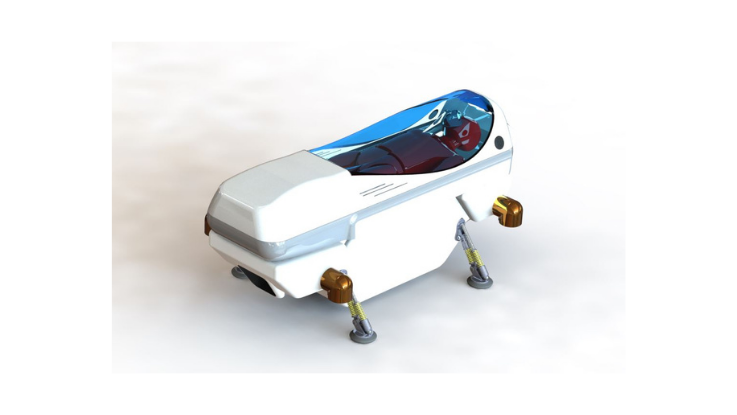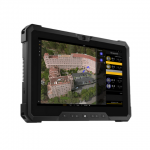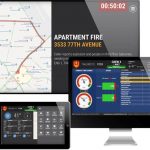Overview
Quad Turbine VTOL Drone
JetQuad is a drone, also known as UAV (Unmanned Aerial Vehicle) or UAS (Unmanned Aerial System). However, the JetQuad relies on new type of propulsion – it is not a quadcopter, nor a helicopter, nor an airplane. Four microturbine jet-engines produce a combined 200-Horsepower at full throttle and are all coupled with proprietary Thrust Vectoring Systems. We refer to this design as the “H-Configuration” – this is the first ever configuration in which the jet-engines alone provide the power for both vertical and horizontal flight as well as complete attitude control of the vehicle. The result is a compact, fully-autonomous, all-diesel drone, that can take-off and land virtually from any surface and capable of high speeds and payload capacity. FusionFlight has been developing JetQuad since 2016, check out some of the articles published over the years.
In addition, the high-precision Thrust Vectoring Systems (TVS) offer numerous advantages over modern multicopters. The TVS are actuated by high-torque servos which have significantly faster response time then the brushless motors/propellers used on ordinary electrical drones. As a result, the JetQuad is more agile and more controllable. The TVS also allow the channeling of engine exhaust from all four turbines in the aft direction of the drone during horizontal flight. Consequently, the JetQuad can utilize the power of all four engines to attain top-speeds unimaginable for similar-by-size VTOL aircraft.
Production and Sales
The AB5 JetQuad is a prototype model. We are actively working on finalizing our pilot model AB6 JetQuad (by improving overall vehicle reliability and expanding the flight envelope). This version will be available for sale starting in the summer of 2021, pending qualification testing. Variants with larger engines and improved aerodynamics will follow later.
Compact and Lightweight
The JetQuad base version is specifically designed so that it can easily be carried by a single person. Empty and unloaded, the drone weighs 24kg (52lb) and has convenient rails to hold onto. In addition, the incredibly small footprint of the drone means it can be transported using most common ground vehicles. It also means that the drone can navigate and land in tight environments normally inaccessible by open-rotor drone technology such as helicopters and quadcopters. FusionFlight will offer optional upgrade package to the JetQuad – retractable landing gear equipped with shock-spring systems. This upgrade will provide the aircraft with less wind resistance during flight and additional flexibility for landing on uneven terrain.
Modularity and Scalability
The JetQuad design is simple and elegant. The drone is built from several modules put together – each module may be disassembled and replaced with minimal effort. The complete design of the drone contains only eight moving components – four turbines and four servo-motors. Such a small quantity of moving parts leads to superb reliability and reduced manufacturing costs, especially when compared to the same-class helicopter. For comparison, helicopters may have hundreds of moving parts and require frequent and often-time expensive maintenance.
Furthermore, the jet-engines are inherently simple and reliable devices that may also be augmented with additional features to greatly boost their performance, resulting a faster and even more capable vehicle. Afterburners, for example, can be readily combined with the proprietary Thrust Vectoring Systems to allow the JetQuad to travel faster then the speed of sound – no other VTOL drone technology in the world today has such potential.
Aerodynamic Packages
The JetQuad base model comes with minimal aerodynamic add-ons. There are two main aerodynamic packages that will be offered as add-ons with the JetQuad: Blended Wing Body (BWB) for missions demanding high-endurance, and Super-Sonic VTOL for applications requiring extremely high-speed.
- Blended Wing Body
For applications requiring high endurance and high range of travel, the JetQuad must be encapsulated in an aerodynamic body. The most aerodynamic configuration is based on features derived from the Blended Wing Body (BWB)design originally developed by NASA and Boeing. This design maximizes internal volume and the lift coefficient of the vehicle body. For the JetQuad, increased lift means that the front two engines can be shut down during cruise while the aft engines are throttled down to 20%. The resulting vehicle maintains the VTOL and high-payload capabilities of the base platform while boosting endurance and range by an order of magnitude. This is just one example of encapsulation for the JetQuad platform – designed specifically towards fuel efficiency. Other designs of the body are also possible, only limited by imagination. - Tachyon – Supersonic VTOL Drone
For applications requiring extreme speed, FusionFlight will offer the Supersonic upgrade package to produce the world’s first compact Supersonic VTOL drone. The AB6X JetQuad is largely based on the AB6 platform for VTOL operations, precision altitude hold, and all-terrain compatibility. In addition, the AB6X is equipped with a highly aerodynamic body designed to sustain supersonic flight. A common inlet which feeds all four turbines is constantly adjusted during all phases of flight to precisely control the amount of air entering the engines. This model will also contain FusionFlight TVS2 (Thrust Vectoring System Second Generation) which will be integrated with full-flow afterburners to provide the thrust needed for supersonic flight. TVS2 will also be capable of full 180-degree vector amplitude, allowing all four turbines to be utilized for forward thrust during horizontal flight.
JetQuad Skycrane Configuration
The flat configuration of the JetQuad allows for both highly aerodynamic horizontal flight as well as the ability to accommodate many different style payloads. Extra-large payloads may be mounted underneath the vehicle and deployed in a very similar manner to the rocket-powered NASA Skycrane system. The JetQuad is essentially a Skycrane except that it is optimized for operation in the Earth’s atmosphere – it is powered by jet-engines instead of rocket engines. In this configuration, the JetQuad would hover about 12ft at the payload drop off location, and slowly lower the payload to the ground via an electrical winch system. All hot gases away from the vehicle during hover allowing for the undercarriage payload to remain cool throughout. Once the payload has successfully touched-down, the JetQuad will disconnect and fly-off. The JetQuad uses microturbine jet-engines that contain built-in generators, useful for powering the Skycrane deployment sequence.
Manned Applications
A large advantage of the JetQuad technology is that it is readily scalable. As the overall mass of the vehicle increases, the mass penalty related to avionics, fuel systems, and structures greatly decreases which results in a very efficient airframe design. For this reason, upon successful production and deployment of the AB6 JetQuad, FusionFlight will focus on developing scaling-up the product for the application of human transportation. These transports will will be powered by eight or more engines to ensure that in the event of an engine failure, no harm is done to the passenger.
- Urban Aerial Mobility (UAM)
The FusionFlight Axion is the largest autonomous aircraft “flying car” that is possible to build using microturbine technology. It is the “supercar” of passenger drones: a two-seater coupe that packs nearly 2000HP from 12x microturbine jet-engines. The Axion will allow FusionFlight to enter and further revolutionize several new transportation markets, specifically ones related to passenger transportation. The Axion may be powered by 8,12 or 16 engines, allowing for engine-loss redundancy. As with all FusionFlight platforms, the Axion platform is propeller-less, with no externally rotating airfoils which greatly maximizes safety. It is also compact and highly-maneuverable. Most importantly, the Axion has been designed from the ground-up to resemble an automobile which makes it very intuitive to fly and operate. - High-Speed Medical Evacuation (MedEvac)
The second notable application of the AB7 platform is Emergency Medical Evacuation (MedeVac), or “Flying Stretcher”. In this configuration, a person is positioned in a horizontal orientation within a standard aerial stretcher (as often used by helicopters) located on top of the platform. However, unlike helicopters, the AB7 Medevac is incredibly compact and will be capable of reaching and rescuing individuals trapped in terrain normally inaccessible by helicopters. Furthermore, survivability of a person greatly depends on how fast he or she gets delivered to the Emergency Room. The top-speed capability of the AB7 Medevac, coupled with high-altitude operation and weather resiliency makes for a robust emergency rescue system.
Details
Vertical Take-Off and Landing
Quick Re-fuel with Diesel / Jet-A
250MPH+ High Speed Cruise
Ready-to-Fly out of the Box
Images
Videos

Sorry, you must be logged in to view the rest of this page
Please log in or create an account to view more details.
Log in or Sign UpCustomers and Partners
Documents

Sorry, you must be logged in to view the rest of this page
Please log in or create an account to view more details.
Log in or Sign UpExpert Analysis

Sorry, you must be logged in to view the rest of this page
Please log in or create an account to view more details.
Log in or Sign Up
































